The creamiest vegan lemon cheesecake topped with eggless lemon curd. This cheesecake is no-bake and made with less than 10 ingredients. You don't need any cashews, coconut oil or agar powder!
This delightful lemon cheesecake was adapted from my popular strawberry cheesecake recipe.
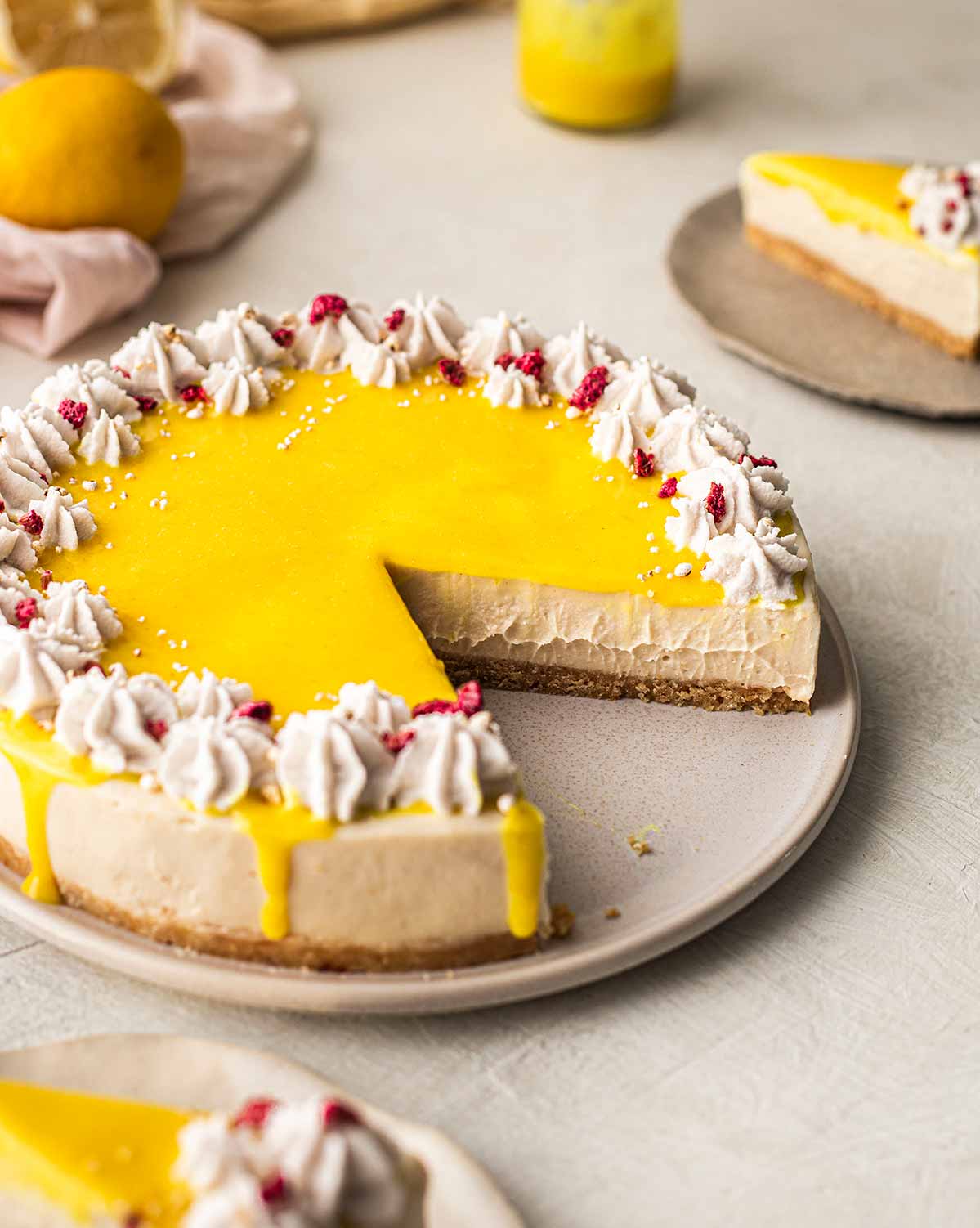
Ingredients you'll need
This vegan lemon cheesecake uses less than 10 ingredients that you can get in major stores (in countries like the USA, Canada, and the UK).
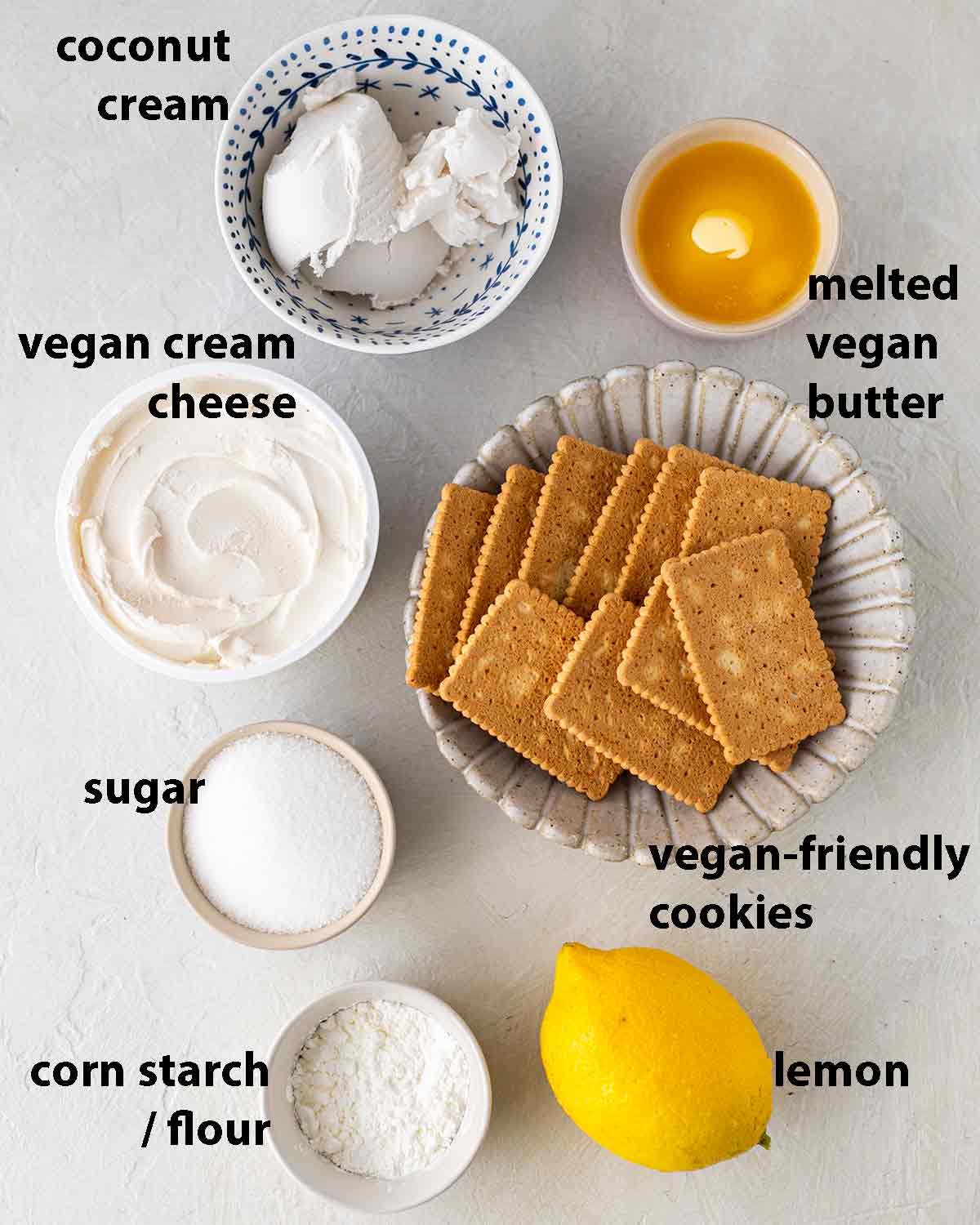
The full list of ingredient quantities and instructions are in the gray recipe card at the bottom of this post.
Vegan cream cheese for a classic cheesecake flavor and texture. As this cheesecake doesn't need to be baked, most brands of cream cheese will work. If you don't have access to vegan cream cheese, check out my baked vegan cheesecake recipe.
Fresh lemon juice and zest for the best lemon flavor!
Vegan-friendly cookies. I used accidentally vegan cookies from a major supermarket. Alternatively, you can use graham crackers with a little sugar.
Coconut cream for texture. Alternatively, you can use more cream cheese. Firm silken tofu will work but you'll need to blend it and your final cheesecake will be softer.
When you scroll down to the recipe card at the bottom of this post, it may look like a lot of ingredients. However, similar ingredients are used in the crust, filling and curd, so it's not too many ingredients
Making the crust
Add the cookies to a small food processor and pulse until it forms fine crumbs. Add the melted vegan butter or coconut oil and pulse until combined.
The mixture should resemble wet sand. Press the mixture into the bottom of your cake tin and you're done.
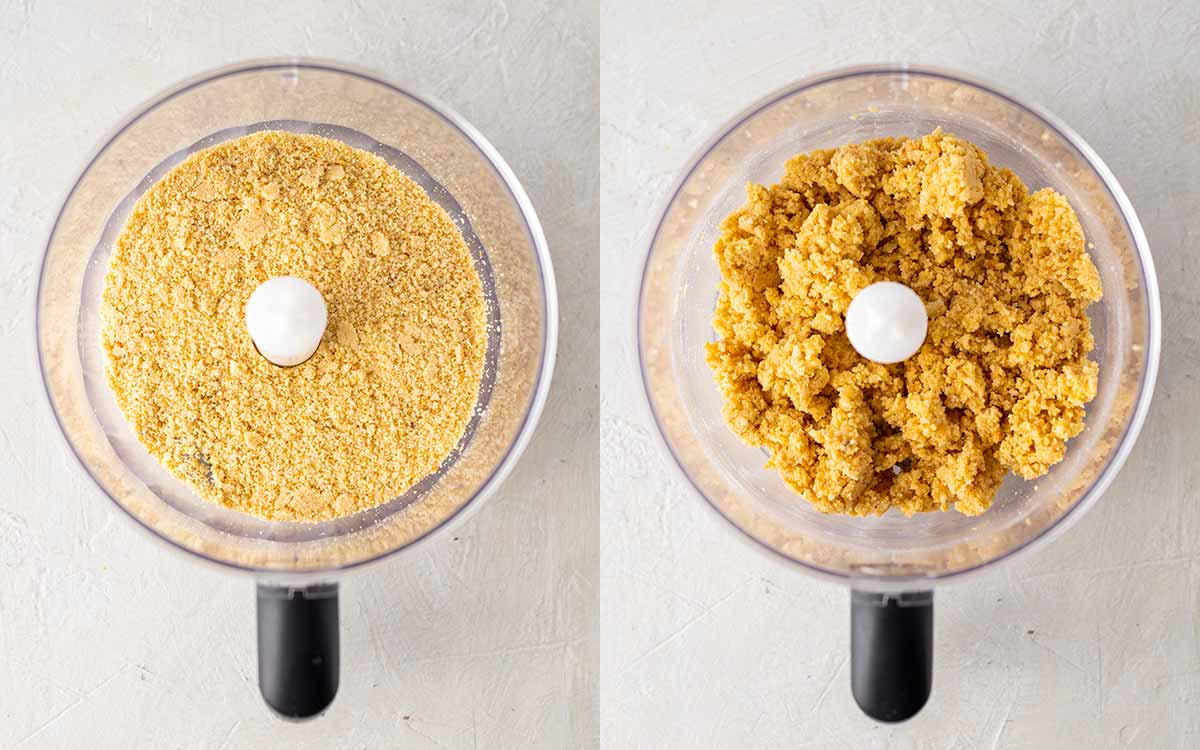
How to make the cheesecake filling
This vegan lemon cheesecake gets its unique creaminess (and setting ability) from a foundation of lemon custard or eggless lemon curd. No cashews, no coconut oil, just traditional stovetop cooking!
To make the 'lemon custard base', add the coconut cream, lemon juice and cornstarch to the saucepan. Whisk the mixture to dissolve the cornstarch - this will help prevent any lumps of cornstarch!
Place the saucepan over medium heat and heat for 5 minutes or until thickened. The mixture may separate and that's absolutely fine! It's ready when it has thickened and you can't 'feel' the powdery cornstarch. Then, remove the saucepan from the heat.
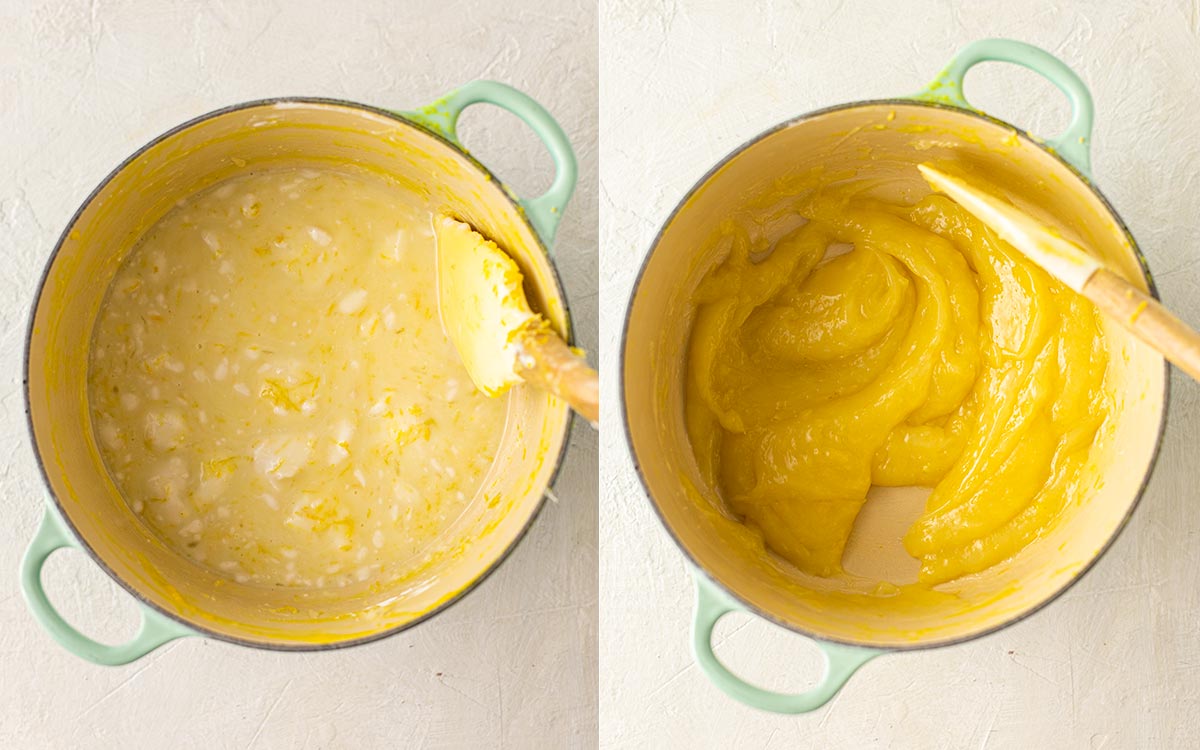
Next, add all your cream cheese to the saucepan and whisk until smooth. The residual heat from the saucepan will help soften the cream cheese and make it easier to mix. You can use either a spatula or a hand mixer for this step! Just make sure there are no lumps of cream cheese at the end.
Alternatively, you can mix the cream cheese and lemon mixture in a food processor or a mixing bowl. I mixed the ingredients in my saucepan for convenience (and for less dirty dishes).
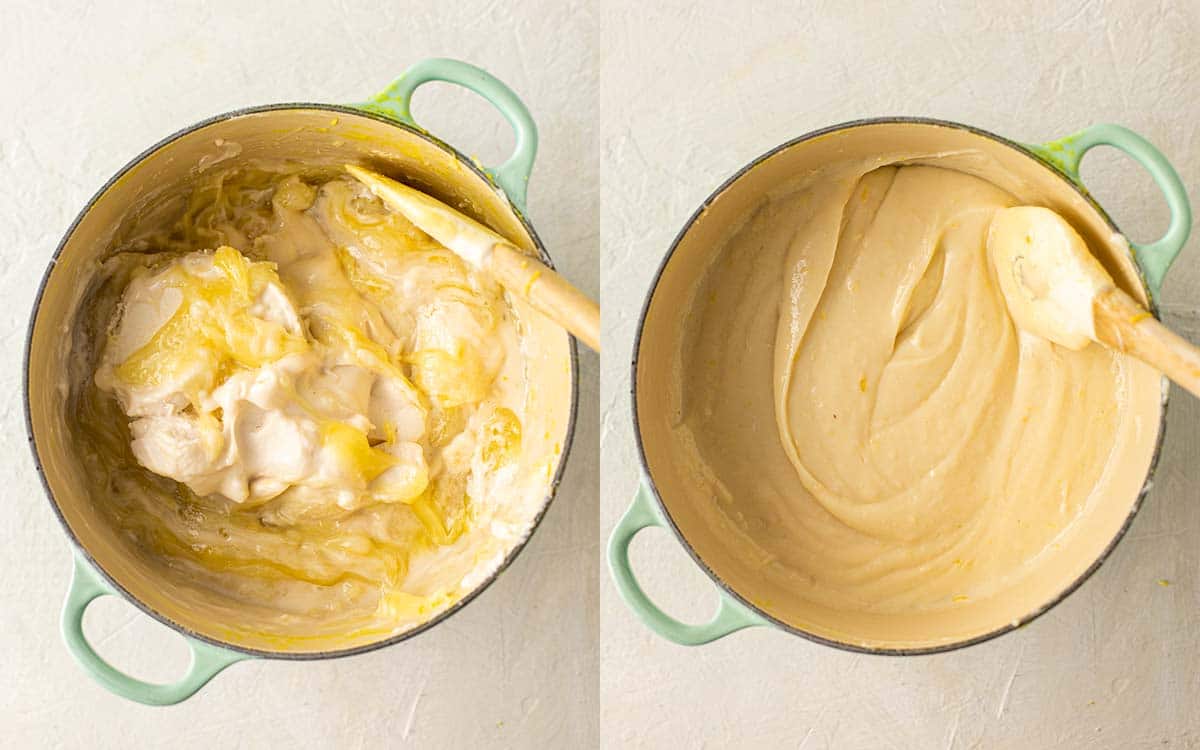
Now you'll have an incredibly creamy yet dairy-free cheesecake mixture. It already tastes SO GOOD at this stage but it'll turn even more creamy over time. Don't eat it all yet! Pour the mixture into your cake tin, smooth the top and let it set.
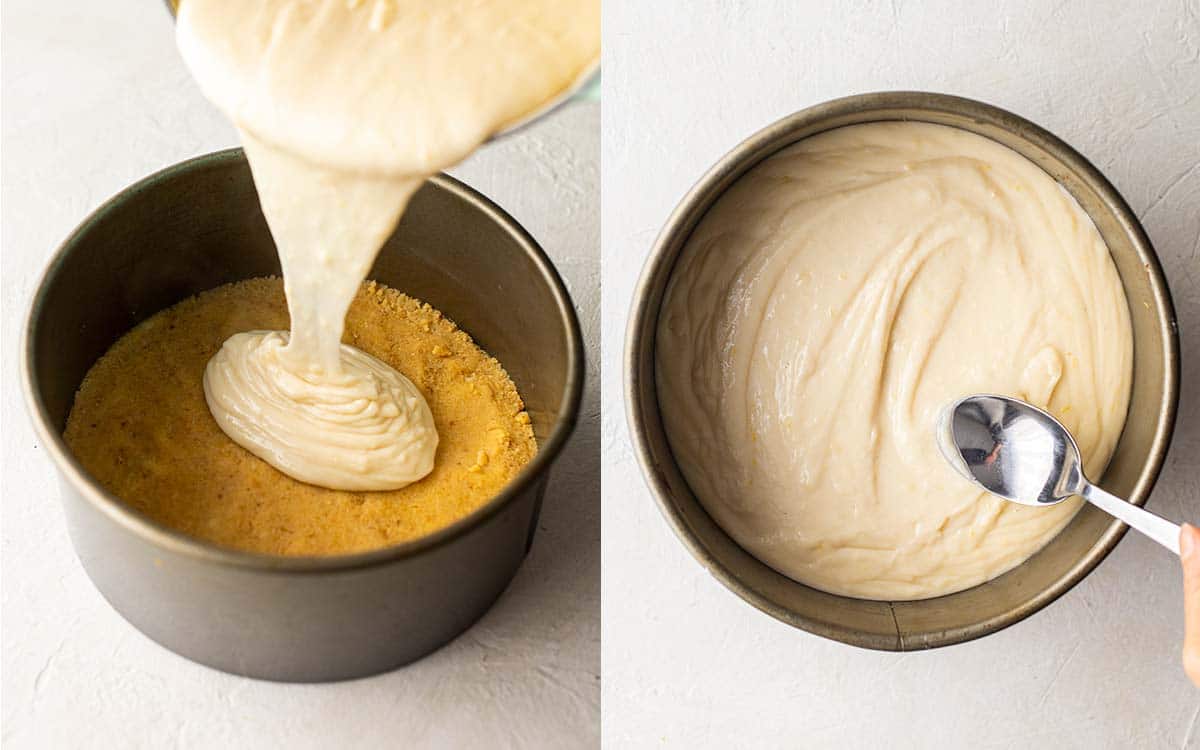
How to make vegan lemon curd (optional)
You know that saucepan we just used? Don't clean it - we'll use it to make the lemon curd.
The eggless lemon curd has similar ingredients to the cheesecake filling. The only different ingredient is turmeric, which is added for color. All ingredient amounts are in the gray recipe box at the bottom of my post.

It's really easy to make vegan lemon curd topping. Simply, add all the ingredients to your saucepan, whisk and heat until thickened! The curd will thicken further when it cools down.
Pour the curd on your vegan lemon cheesecake and let it set further or serve immediately.
The lemon curd is also amazing served with my vegan lemon cake (layered) vegan lemon poppy seed muffins or lemon blueberry cake!
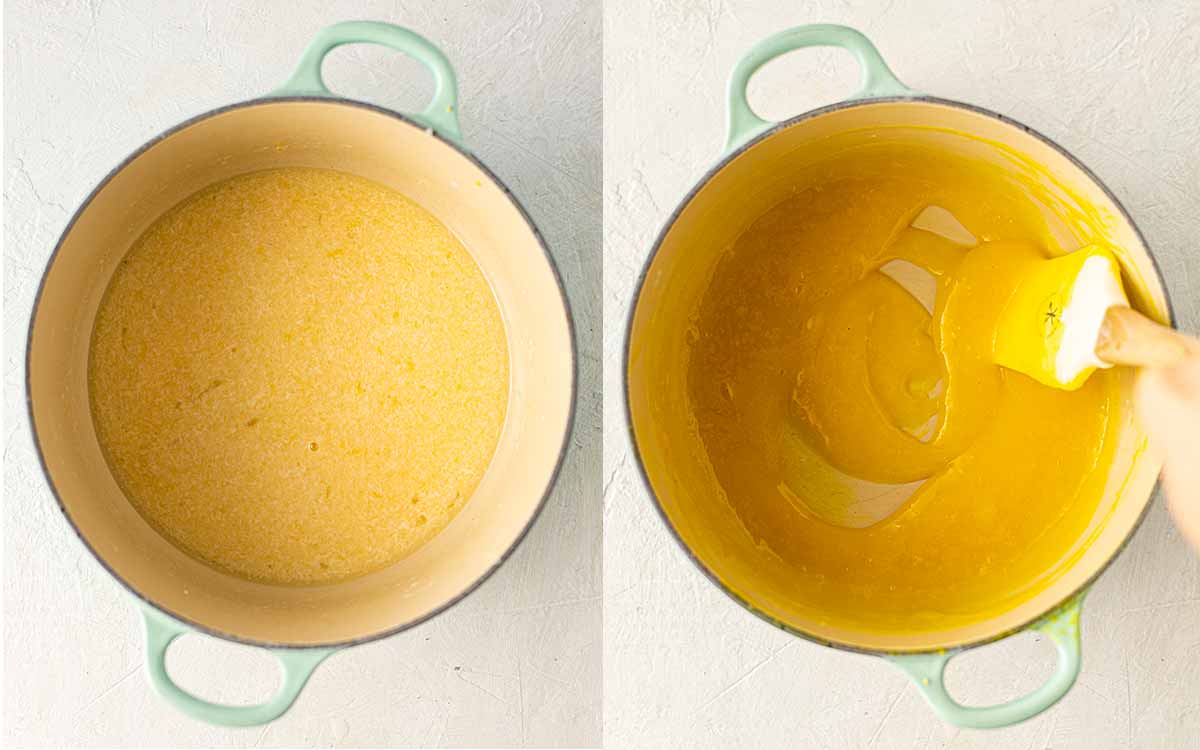
Other ways to decorate the cheesecake
Apart from vegan lemon curd, you can also top your dessert with:
- Fresh berries, mango slices or even kiwi fruit!
- An easy mixed berry compote or strawberry compote, similar to my other vegan cheesecakes.
- Passionfruit puree, like my baked passionfruit cheesecake!
- Coconut yogurt or whipped coconut cream
- Chopped macadamia nuts and flaked coconut
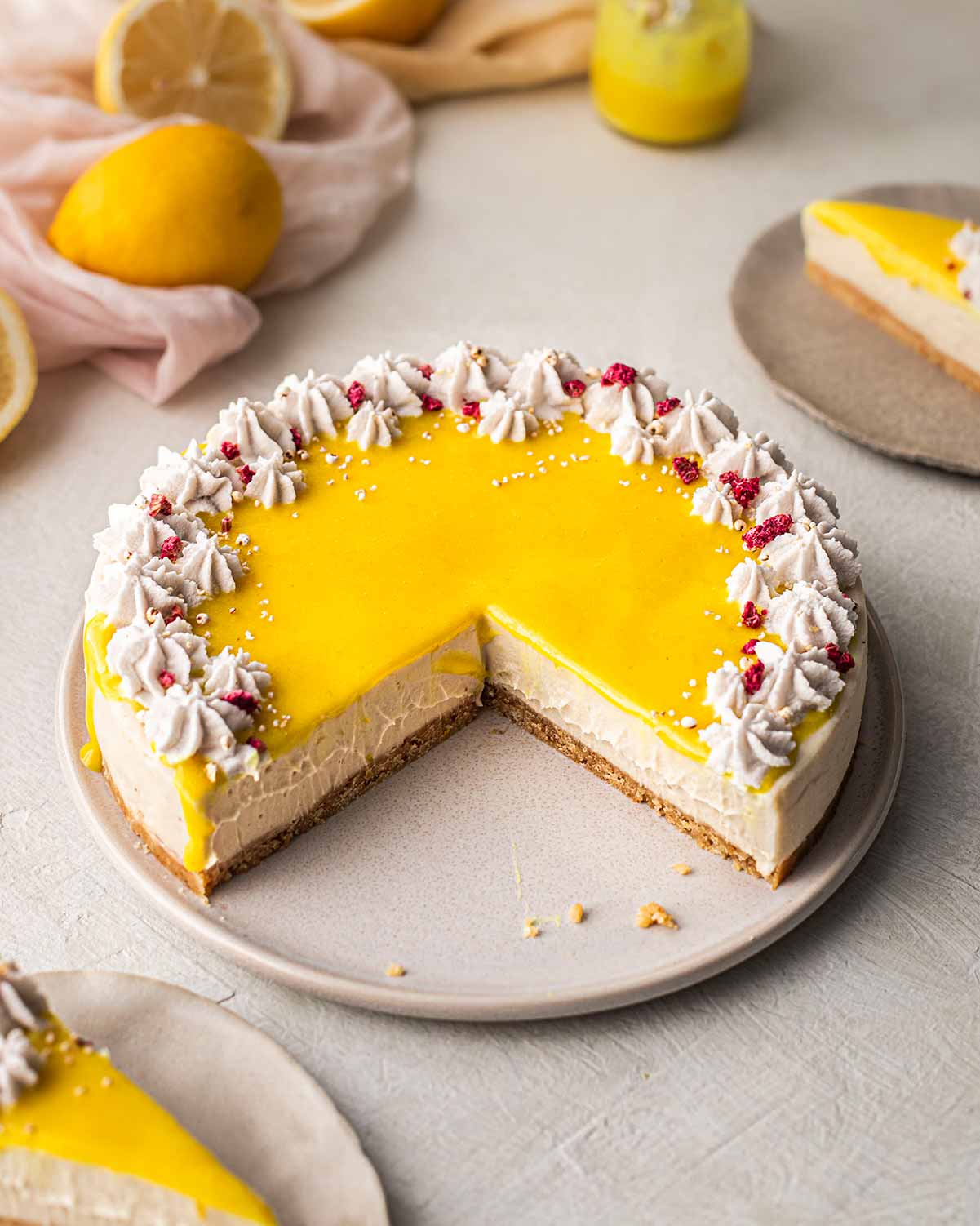
TOP tip!
Make sure you cook the filling and curd on the stovetop for long enough! Use the images in the blog post as a guide. The filling and curd should thickly coat the back of a spatula. Cooking times will vary depending on your stovetop.
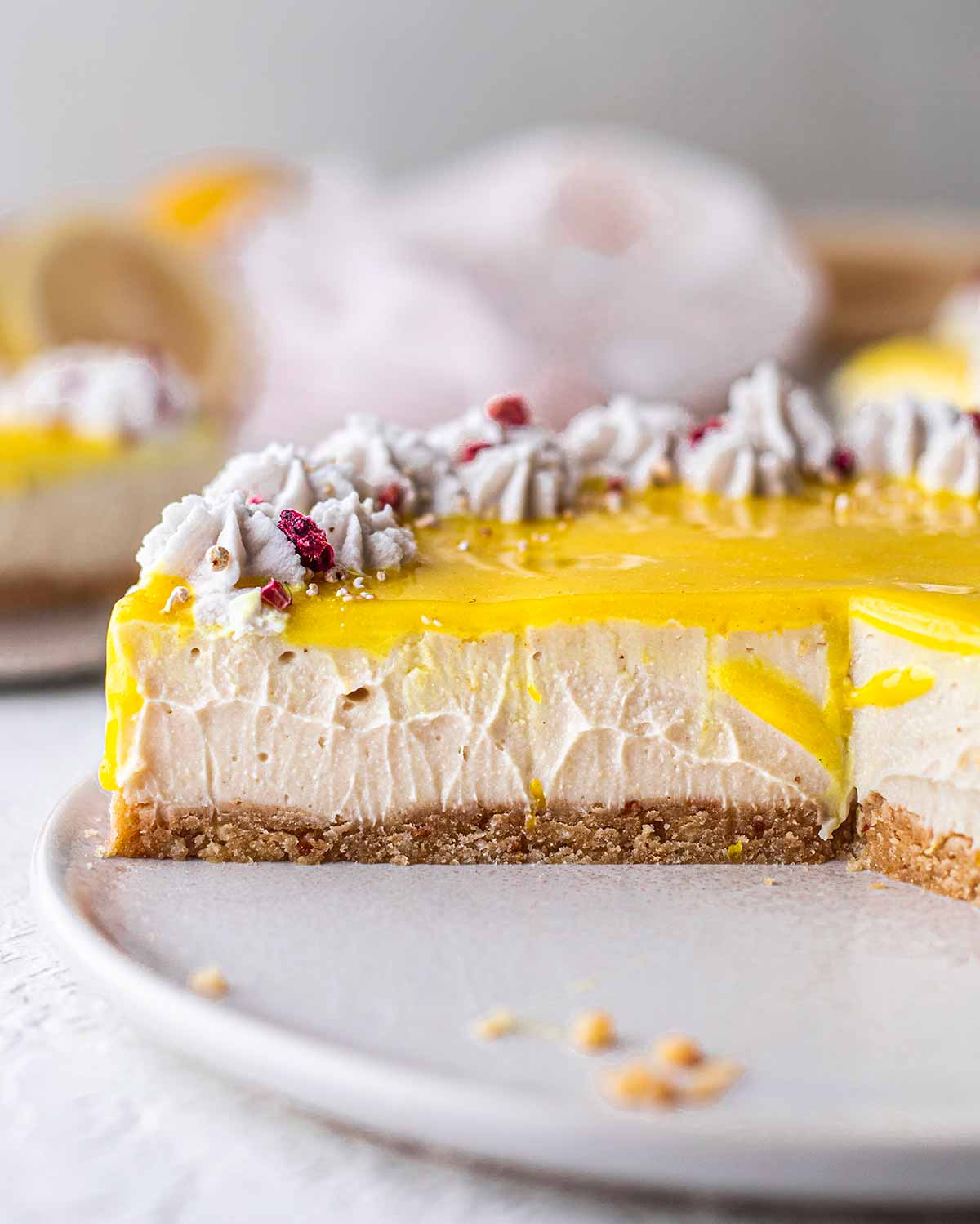
More vegan cheesecake recipes
Vegan Lemon Cheesecake
Ingredients
Crust
- ~2 cups (200g) plain sweet cookies, gluten-free if needed (note 1)
- ⅓ cup (75g) vegan butter, margarine or coconut oil, melted
Cheesecake filling
- 1 cup (240g) thick scoopable canned coconut cream, (note 2)
- ½ cup (100g) granulated sugar, or light-coloured sweetener of choice
- ⅓ cup (70g) lemon juice and zest, or to taste (I used ~2 lemons and weighed the lemon juice and lemon zest together)
- ¼ cup (30g) cornstarch / corn flour
- ~2 cups (480g) vegan cream cheese, room temperature (2 x regular tubs)
Vegan lemon curd (optional)
- 1 cup (120g) dairy-free milk
- 1 tablespoon cornstarch / corn flour
- ¼ cup (50g) granulated sugar
- 2 tablespoons (30g) lemon juice and zest, or to taste (I used ~½ lemon and weighed the lemon juice and zest together)
- Pinch of turmeric
Instructions
- Line an 8-inch (20 cm) spring-form or loose-bottom cake pan with parchment paper.
To make the crust:
- Add the cookies to a food processor and pulse until fine crumbs. Add the melted butter and pulse until combined. Firmly press the mixture into the bottom of your cake pan. Set aside.
To make the filling:
- Add the coconut cream, sugar, lemon juice and cornstarch to a medium size saucepan and whisk to dissolve the cornstarch. Place the saucepan over medium heat and stir the mixture constantly for 5 minutes or until it resembles a thick lemon curd. It's ok if the mixture separates! Remove from the heat.
- Add the cream cheese to the saucepan (note 3). Mix until the cream cheese is fully combined with the coconut cream mixture. There shouldn't be any lumps and your mixture should be a little thick (refer to the images above).
- Pour the mixture into your lined cake pan and smooth the top. Cover the cheesecake and place it in the fridge for at least 4 hours or until set.
To make the vegan lemon curd (optional):
- Add all ingredients to a medium-sized saucepan and whisk to dissolve the cornstarch. Place the saucepan over medium heat and stir constantly for 5 minutes or until the mixture thickens. The curd will thicken more when it cools down.
- Remove the cheesecake from the cake pan, pour or spread your lemon curd on top and serve!
- Store leftovers in an airtight container for up to 3 days or in the freezer for up to 1 month.
Notes
- Alternatively, you can use 150g graham crackers and 50g granulated sugar.
- If you can, avoid buying light canned coconut cream or even full-fat coconut milk as they contain less 'thick scoopable cream' compared to regular canned coconut cream. Otherwise, you'll need to buy too many cans to get the required amount of coconut cream in the recipe. If you don't want to use coconut cream, you can substitute it with more vegan cream cheese. Or, you can use firm silken tofu if you add it to a blender (your cheesecake will also be softer).
- Adding the cream cheese to the saucepan allows the residual heat to soften the cream cheese (it makes mixing easier and there's one less dish for you to clean)! Alternatively, you can add all the cheesecake filling ingredients to a food processor or mixing bowl and mix until smooth.
Nutrition
This post may contain affiliate links. As an Amazon Associate, I may earn a small commission from qualifying purchases at no additional cost to you.


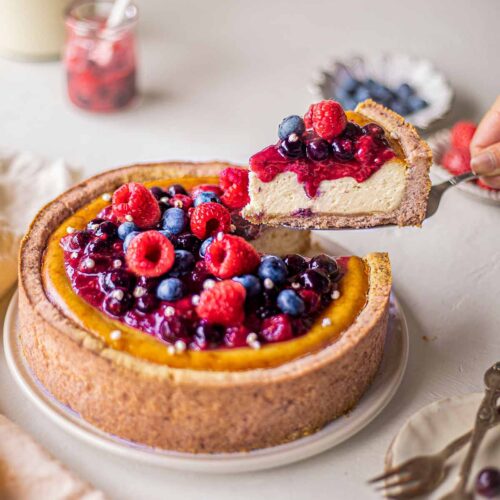
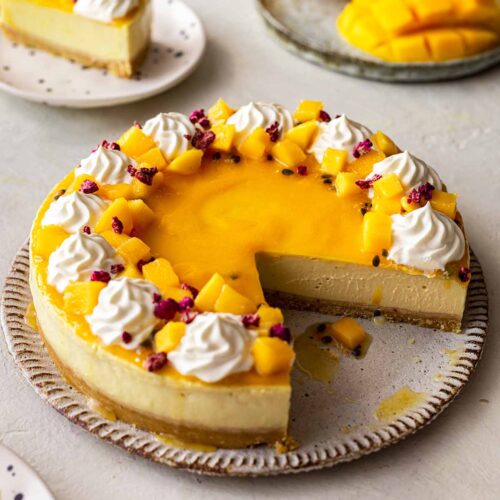
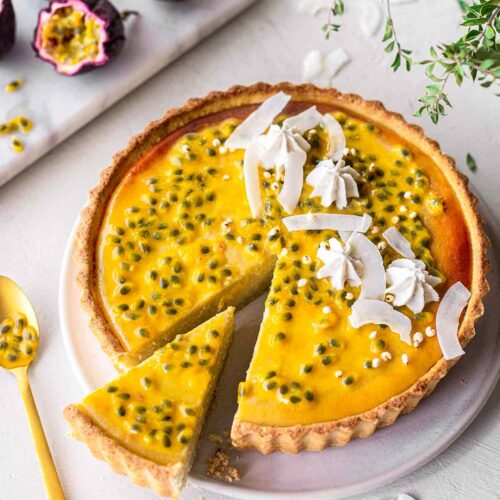
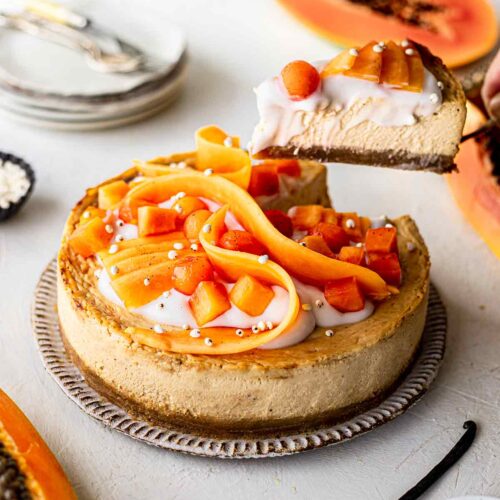
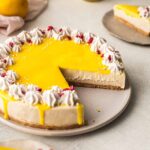
I made this for an Easter gathering and it was a hit! I accidentally missed the part about only using scoopable coconut cream, but it turned out ok. I’ll try again with only scoopable cream next time though.
I just passed by to thank you for the clarity and the suitability to all readers. I was looking for a Vegan recipe with the ingredients stated in grams and thankfully I’ve found you! Very clear, passionate and careful to many details (even the advice to avoid cleaning too much dishes!😂👌👌)
I didn’t even make this recipe and I already love it. I will do it for Easter and I can’t wait 🐣🌸
So thank you for your hard work!
By Joel